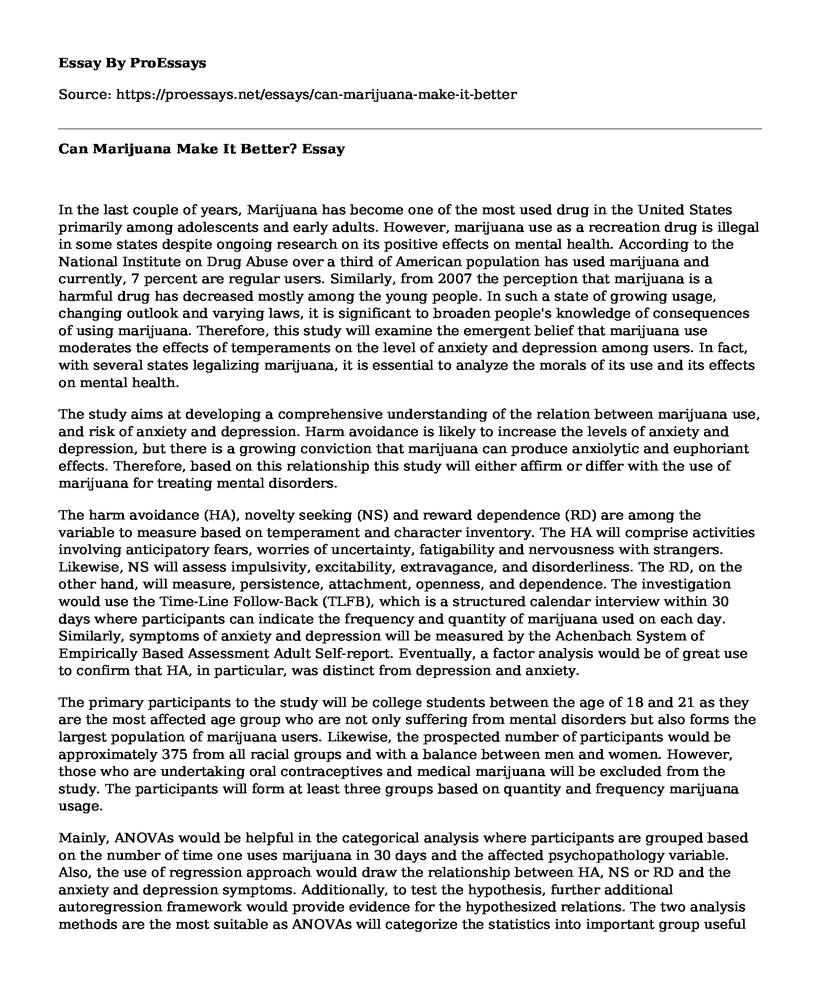In the last couple of years, Marijuana has become one of the most used drug in the United States primarily among adolescents and early adults. However, marijuana use as a recreation drug is illegal in some states despite ongoing research on its positive effects on mental health. According to the National Institute on Drug Abuse over a third of American population has used marijuana and currently, 7 percent are regular users. Similarly, from 2007 the perception that marijuana is a harmful drug has decreased mostly among the young people. In such a state of growing usage, changing outlook and varying laws, it is significant to broaden people's knowledge of consequences of using marijuana. Therefore, this study will examine the emergent belief that marijuana use moderates the effects of temperaments on the level of anxiety and depression among users. In fact, with several states legalizing marijuana, it is essential to analyze the morals of its use and its effects on mental health.
The study aims at developing a comprehensive understanding of the relation between marijuana use, and risk of anxiety and depression. Harm avoidance is likely to increase the levels of anxiety and depression, but there is a growing conviction that marijuana can produce anxiolytic and euphoriant effects. Therefore, based on this relationship this study will either affirm or differ with the use of marijuana for treating mental disorders.
The harm avoidance (HA), novelty seeking (NS) and reward dependence (RD) are among the variable to measure based on temperament and character inventory. The HA will comprise activities involving anticipatory fears, worries of uncertainty, fatigability and nervousness with strangers. Likewise, NS will assess impulsivity, excitability, extravagance, and disorderliness. The RD, on the other hand, will measure, persistence, attachment, openness, and dependence. The investigation would use the Time-Line Follow-Back (TLFB), which is a structured calendar interview within 30 days where participants can indicate the frequency and quantity of marijuana used on each day. Similarly, symptoms of anxiety and depression will be measured by the Achenbach System of Empirically Based Assessment Adult Self-report. Eventually, a factor analysis would be of great use to confirm that HA, in particular, was distinct from depression and anxiety.
The primary participants to the study will be college students between the age of 18 and 21 as they are the most affected age group who are not only suffering from mental disorders but also forms the largest population of marijuana users. Likewise, the prospected number of participants would be approximately 375 from all racial groups and with a balance between men and women. However, those who are undertaking oral contraceptives and medical marijuana will be excluded from the study. The participants will form at least three groups based on quantity and frequency marijuana usage.
Mainly, ANOVAs would be helpful in the categorical analysis where participants are grouped based on the number of time one uses marijuana in 30 days and the affected psychopathology variable. Also, the use of regression approach would draw the relationship between HA, NS or RD and the anxiety and depression symptoms. Additionally, to test the hypothesis, further additional autoregression framework would provide evidence for the hypothesized relations. The two analysis methods are the most suitable as ANOVAs will categorize the statistics into important group useful in regression analysis. Therefore, the two strategy analysis is complementary to reveal significant effects of marijuana on mental health.Conclusion
In conclusion, the interested participant and those who are eligible for recruitment should comply and avail themselves for an interview via a phone call from study personnel. Afterward, they are grouped and are expected to participate in six laboratory sessions over three years. During this period they should desist from liquor for 24 hours, recreation drugs including marijuana for 6 hours and caffeine and a cigarette for 1 hour before attending any laboratory session. Nevertheless, although it is difficult to monitor abstinence, those who comply would develop high self-control. Later, each participant should fill a TLFB and the prepared questionnaire for the session used in the analysis.
Cite this page
Can Marijuana Make It Better?. (2022, Apr 04). Retrieved from https://proessays.net/essays/can-marijuana-make-it-better
If you are the original author of this essay and no longer wish to have it published on the ProEssays website, please click below to request its removal:
- Brief Description of My Community - Course Work Example
- Intercultural Learning, Global Health, and Nursing: Teaching and Learning Strategies
- Asthma in Hispanic Children Essay Example
- Medical Essay on Chest Pain
- Essay Sample on Criminal Justice System with Reference to Privatization
- Novel Covid-19: Effects on Individual, Local & Global Levels - Essay Sample
- Communication Skills - Free Essay Sample







